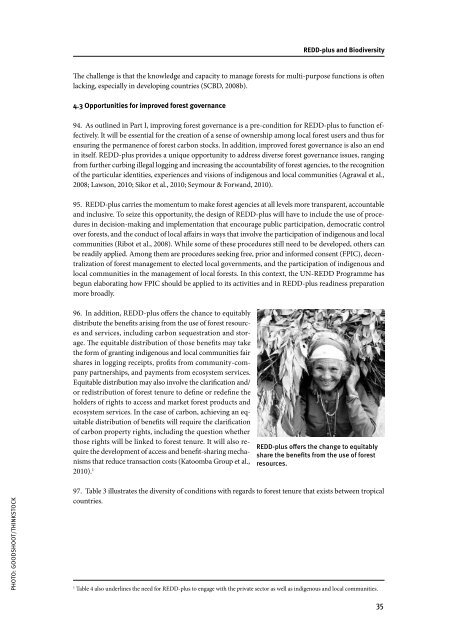REDD-plus and Biodiversity - Convention on Biological Diversity
REDD-plus and Biodiversity - Convention on Biological Diversity
REDD-plus and Biodiversity - Convention on Biological Diversity
You also want an ePaper? Increase the reach of your titles
YUMPU automatically turns print PDFs into web optimized ePapers that Google loves.
<str<strong>on</strong>g>REDD</str<strong>on</strong>g>-<str<strong>on</strong>g>plus</str<strong>on</strong>g> <str<strong>on</strong>g>and</str<strong>on</strong>g> <str<strong>on</strong>g>Biodiversity</str<strong>on</strong>g><br />
The challenge is that the knowledge <str<strong>on</strong>g>and</str<strong>on</strong>g> capacity to manage forests for multi-purpose functi<strong>on</strong>s is often<br />
lacking, especially in developing countries (SCBD, 2008b).<br />
4.3 Opportunities for improved forest governance<br />
94. As outlined in Part I, improving forest governance is a pre-c<strong>on</strong>diti<strong>on</strong> for <str<strong>on</strong>g>REDD</str<strong>on</strong>g>-<str<strong>on</strong>g>plus</str<strong>on</strong>g> to functi<strong>on</strong> effectively.<br />
It will be essential for the creati<strong>on</strong> of a sense of ownership am<strong>on</strong>g local forest users <str<strong>on</strong>g>and</str<strong>on</strong>g> thus for<br />
ensuring the permanence of forest carb<strong>on</strong> stocks. In additi<strong>on</strong>, improved forest governance is also an end<br />
in itself. <str<strong>on</strong>g>REDD</str<strong>on</strong>g>-<str<strong>on</strong>g>plus</str<strong>on</strong>g> provides a unique opportunity to address diverse forest governance issues, ranging<br />
from further curbing illegal logging <str<strong>on</strong>g>and</str<strong>on</strong>g> increasing the accountability of forest agencies, to the recogniti<strong>on</strong><br />
of the particular identities, experiences <str<strong>on</strong>g>and</str<strong>on</strong>g> visi<strong>on</strong>s of indigenous <str<strong>on</strong>g>and</str<strong>on</strong>g> local communities (Agrawal et al.,<br />
2008; Laws<strong>on</strong>, 2010; Sikor et al., 2010; Seymour & Forw<str<strong>on</strong>g>and</str<strong>on</strong>g>, 2010).<br />
95. <str<strong>on</strong>g>REDD</str<strong>on</strong>g>-<str<strong>on</strong>g>plus</str<strong>on</strong>g> carries the momentum to make forest agencies at all levels more transparent, accountable<br />
<str<strong>on</strong>g>and</str<strong>on</strong>g> inclusive. To seize this opportunity, the design of <str<strong>on</strong>g>REDD</str<strong>on</strong>g>-<str<strong>on</strong>g>plus</str<strong>on</strong>g> will have to include the use of procedures<br />
in decisi<strong>on</strong>-making <str<strong>on</strong>g>and</str<strong>on</strong>g> implementati<strong>on</strong> that encourage public participati<strong>on</strong>, democratic c<strong>on</strong>trol<br />
over forests, <str<strong>on</strong>g>and</str<strong>on</strong>g> the c<strong>on</strong>duct of local affairs in ways that involve the participati<strong>on</strong> of indigenous <str<strong>on</strong>g>and</str<strong>on</strong>g> local<br />
communities (Ribot et al., 2008). While some of these procedures still need to be developed, others can<br />
be readily applied. Am<strong>on</strong>g them are procedures seeking free, prior <str<strong>on</strong>g>and</str<strong>on</strong>g> informed c<strong>on</strong>sent (FPIC), decentralizati<strong>on</strong><br />
of forest management to elected local governments, <str<strong>on</strong>g>and</str<strong>on</strong>g> the participati<strong>on</strong> of indigenous <str<strong>on</strong>g>and</str<strong>on</strong>g><br />
local communities in the management of local forests. In this c<strong>on</strong>text, the UN-<str<strong>on</strong>g>REDD</str<strong>on</strong>g> Programme has<br />
begun elaborating how FPIC should be applied to its activities <str<strong>on</strong>g>and</str<strong>on</strong>g> in <str<strong>on</strong>g>REDD</str<strong>on</strong>g>-<str<strong>on</strong>g>plus</str<strong>on</strong>g> readiness preparati<strong>on</strong><br />
more broadly.<br />
96. In additi<strong>on</strong>, <str<strong>on</strong>g>REDD</str<strong>on</strong>g>-<str<strong>on</strong>g>plus</str<strong>on</strong>g> offers the chance to equitably<br />
distribute the benefits arising from the use of forest resources<br />
<str<strong>on</strong>g>and</str<strong>on</strong>g> services, including carb<strong>on</strong> sequestrati<strong>on</strong> <str<strong>on</strong>g>and</str<strong>on</strong>g> storage.<br />
The equitable distributi<strong>on</strong> of those benefits may take<br />
the form of granting indigenous <str<strong>on</strong>g>and</str<strong>on</strong>g> local communities fair<br />
shares in logging receipts, profits from community-company<br />
partnerships, <str<strong>on</strong>g>and</str<strong>on</strong>g> payments from ecosystem services.<br />
Equitable distributi<strong>on</strong> may also involve the clarificati<strong>on</strong> <str<strong>on</strong>g>and</str<strong>on</strong>g>/<br />
or redistributi<strong>on</strong> of forest tenure to define or redefine the<br />
holders of rights to access <str<strong>on</strong>g>and</str<strong>on</strong>g> market forest products <str<strong>on</strong>g>and</str<strong>on</strong>g><br />
ecosystem services. In the case of carb<strong>on</strong>, achieving an equitable<br />
distributi<strong>on</strong> of benefits will require the clarificati<strong>on</strong><br />
of carb<strong>on</strong> property rights, including the questi<strong>on</strong> whether<br />
those rights will be linked to forest tenure. It will also require<br />
the development of access <str<strong>on</strong>g>and</str<strong>on</strong>g> benefit-sharing mechanisms<br />
that reduce transacti<strong>on</strong> costs (Katoomba Group et al.,<br />
2010). 1<br />
<str<strong>on</strong>g>REDD</str<strong>on</strong>g>-<str<strong>on</strong>g>plus</str<strong>on</strong>g> offers the change to equitably<br />
share the benefits from the use of forest<br />
resources.<br />
PHOTO: Goodshoot/Thinkstock<br />
97. Table 3 illustrates the diversity of c<strong>on</strong>diti<strong>on</strong>s with regards to forest tenure that exists between tropical<br />
countries.<br />
1<br />
Table 4 also underlines the need for <str<strong>on</strong>g>REDD</str<strong>on</strong>g>-<str<strong>on</strong>g>plus</str<strong>on</strong>g> to engage with the private sector as well as indigenous <str<strong>on</strong>g>and</str<strong>on</strong>g> local communities.<br />
35

















